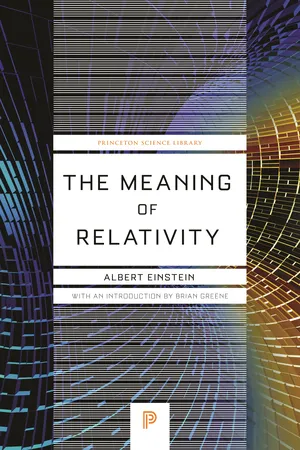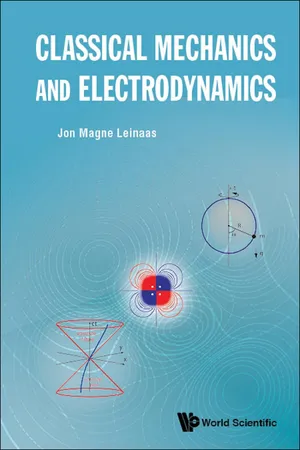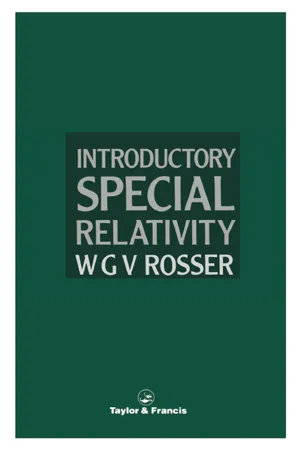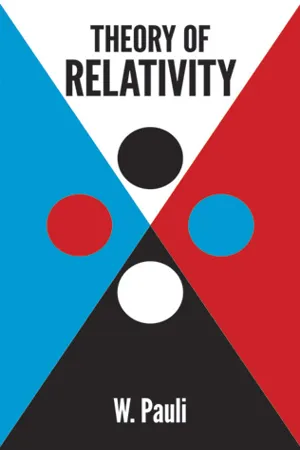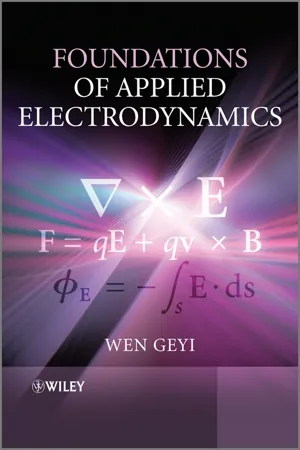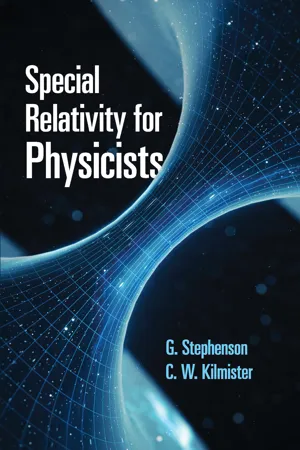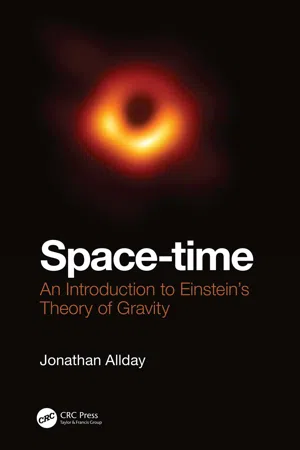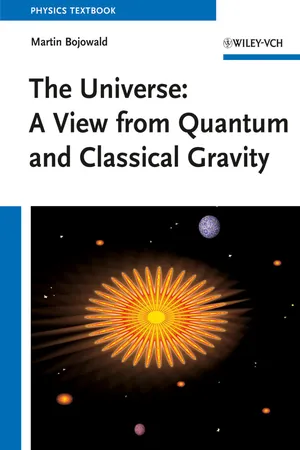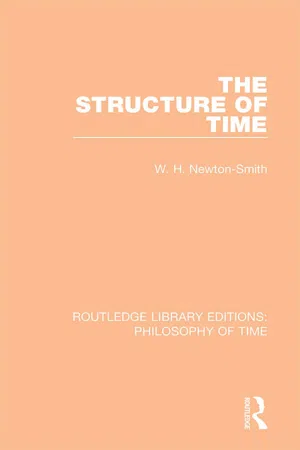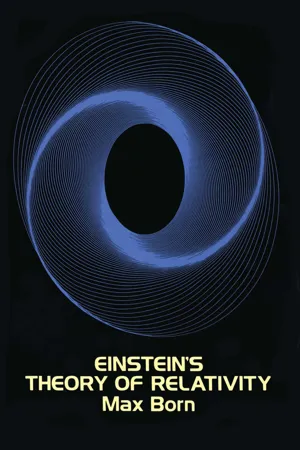Physics
Lorentz Transformations
Lorentz transformations are a set of equations that describe how measurements of space and time change for observers in different inertial reference frames, particularly when considering objects moving at relativistic speeds. They are a fundamental component of Einstein's theory of special relativity and are used to reconcile the differences in measurements made by observers in relative motion.
Written by Perlego with AI-assistance
Related key terms
Related key terms
1 of 4
Related key terms
1 of 3
12 Key excerpts on "Lorentz Transformations"
- eBook - ePub
Radioactivity
History, Science, Vital Uses and Ominous Peril
- Michael F. L'Annunziata(Author)
- 2022(Publication Date)
- Elsevier(Publisher)
Einstein never received a Nobel prize for relativity. The committee was at first cautious and waited for experimental confirmation. By the time such confirmation was available Einstein had moved on to further momentous work.In the biographical sketch of Albert Einstein, a discussion of Einstein's relativity is included together with Einstein's application of the Lorentz Transformations in relativistic calculations. A derivation of the Lorentz Transformations is found in Appendix C. In Einstein's writings on relativity (Einstein, 1916), he provided examples of how measurements made from one frame of reference on another frame of reference will yield different measurements of time and length dependent on the frame of reference from which the measurements are taken and the velocity v at which an object is traveling relative to an observer.Certain terms in the Lorentz Transformations, including those used by Einstein in his special theory of relativity, are the following:(2.50)which is referred to as the Lorentz factor, used to measure time dilation, length contraction, and energy and mass in relativity. This factor is utilized in various chapters of this book; and v is the velocity of an observer or particle, which never achieves the velocity of light in a vacuum, and c is the speed of light in a vacuum. Another term:(2.51)will be found in use throughout the book where the factor in β = v/c where β is the relative phase velocity of a particle or the velocity of a particle relative to the speed of light in a vacuum.In the biographical sketch of Hendrik A. Lorentz provided by the Nobel Foundation in a link to the Nobel Prize in Physics awarded to Lorentz, the following is stated:The so-called Lorentz transformation (Lorentz, 1904 ) was based on the fact that electromagnetic forces between charges are subject to light alterations due to their motion, resulting in a minute contraction in the size of moving bodies. It … paved the way for Einstein's special theory of relativity.Kox (2005) of the University of Amsterdam published his Robert H. Dicke Lecture at the 2005 American Physical Society (APS) Meeting held in Los Angeles, March 21–25, 2005. Kox underscores the close ties of friendship between Einstein and Lorentz, in particular, he noted that Einstein called Lorentz a “living work of art” and Lorentz had deep admiration for Einstein's genius. Kox analyses the personal relationship between the two Nobel Laureates. He discusses the historical relationship between H.A. Lorentz’s electron theory and special relativity, especially the question to what extent Lorentz can be considered a forerunner to Einstein (http://meetings.aps.org/link/BAPS.2005.MAR.B5.2 - eBook - ePub
Princeton Science Library
Including the Relativistic Theory of the Non-Symmetric Field - Fifth Edition
- Albert Einstein(Author)
- 2014(Publication Date)
- Princeton University Press(Publisher)
µα must satisfy the conditionsSince the ratios of the xν are real, it follows that all the aµ and the bµα are real, except a4 , b41 , b42 , b43 , b14 , b24 , and b34 , which are purely imaginary.Special Lorentz Transformation. We obtain the simplest transformations of the type of (24 ) and (25) if only two of the co-ordinates are to be transformed, and if all the aµ , which merely determine the new origin, vanish. We obtain then for the indices 1 and 2, on account of the three independent conditions which the relations (25 ) furnish,This is a simple rotation in space of the (space) co-ordinate system about the x3 -axis. We see that the rotational transformation in space (without the time transformation) which we studied before is contained in the Lorentz transformation as a special case. For the indices 1 and 4 we obtain, in an analogous manner,On account of the relations of reality ψ must be taken as imaginary. To interpret these equations physically, we introduce the real light-time l and the velocity υ of K′ relatively to K, instead of the imaginary angle ψ. We have, first,Since for the origin of K′, i.e., for , we must have x1 = υl, it follows from the first of these equations thatand also so that we obtainThese equations form the well-known special Lorentz transformation, which in the general theory represents a rotation, through an imaginary angle, of the four-dimensional system of co-ordinates. If we introduce the ordinary time t, in place of the light-time l, then in (29 ) we must replace l by ct and ν by .We must now fill in a gap. From the principle of the constancy of the velocity of light it follows that the equation - eBook - ePub
- Jon Magne Leinaas(Author)
- 2018(Publication Date)
- WSPC(Publisher)
The relativistic velocity formula implies that if a particle moves with subluminal velocity in one inertial frame, it will move with subluminal velocity in any other inertial frame. The transformation formula does not, in a strict sense, exclude the possibility of superluminal velocity, which then, again as a consequence of the velocity formula, will have to be superluminal in all inertial frames. However, as we shall later see, this will create a problem for a causal understanding of processes where energy and momentum are exchanged over distance. The usual understanding of relativity is therefore that any signal that transports energy, or any form of information, has to propagate with a speed slower than, or equal to, the speed of light.4.2Rotations, boosts and the invariant distance
The Lorentz Transformations (4.3 ) are often referred to as boosts or special Lorentz Transformations. Such a transformation can be viewed as taking the first reference frame S and changing its velocity in some direction (here the x-direction) without rotating its coordinate axes, and thereby creating the new reference frame S′. The general Lorentz Transformations are considered as transformations that include both boosts and rotations.There is in fact a formal resemblance between rotations and the boosts. To see this we first consider a rotation in the x, y-plane, which in Cartesian coordinates takes the form,where ϕ is the rotation angle. The typical feature of the rotations is that the distance between two points is left invariant by the transformations. For the transformation (4.8 ) this invariance is expressed bywith Δx and Δy representing the coordinate difference between two points and Δs the relative distance between the points.For the Lorentz Transformations (4.3 ) we introduce a new parameter χ in the following way3with β as the standard abbreviation for the dimensionless velocity β = v/c. This is a consistent parametrization, since the two expressions satisfy the requirement of hyperbolic functions,The parameter χ, which is related to the relative velocity v of the two reference frames by the equationis referred to as rapidity and is sometimes a more convenient parameter to use than the velocity. It is here introduced in order to give the Lorentz Transformations a form similar to that of rotations. For the special transformation (4.3 ) it takes the formFig. 4.2Comparison between a rotation in the (x, y) plane and a boost in the (ct, x) plane. In the first case the rotation will transform an orthogonal coordinate frame into a rotated orthogonal frame. In the second case the orthogonal frame will not appear as orthogonal after the transformation. However, the meaning of orthogonality is in fact changed when time is introduced as a new space-time - eBook - ePub
- W G V Rosser(Author)
- 2017(Publication Date)
- CRC Press(Publisher)
4 Special Relativity and the Lorentz Transformations 4.1 POSTULATES OF SPECIAL RELATIVITY Einstein’s two main postulates in the theory of special relativity were (i) the principle of relativity; (ii) the principle of the constancy of the speed of light.According to the principle of relativity, the laws of physics, including the laws of relativistic mechanics and of optics, electromagnetism and nuclear physics, are the same in all inertial reference frames.The definition of an inertial reference frame is the same in the theory of special relativity as in Newtonian mechanics (cf. Section 1.2.2 ). As an example of the scope of the principle of relativity in the theory of special relativity, consider a spaceship coasting along with uniform velocity with respect to the fixed stars. If an astronaut performed experiments in mechanics, optics, electromagnetism or nuclear physics inside the spaceship, according to the principle of relativity the laws the astronaut would “derive” on the basis of these experiments would be the same as if they were carried out in any other inertial reference frame such as the laboratory frame. Without looking at anything external to the spaceship, the astronaut could not even say if it was moving, and could not determine its speed relative to the Earth. The astronaut should find no preferred directions in space.It was shown in Section 2.13 that if the laws of relativistic mechanics, developed in Chapter 2 , are to obey the principle of relativity then the appropriate coordinate and time transformations are the Lorentz Transformations. Similarly, the Lorentz Transformations are the appropriate transformations if the laws of electromagnetism (Maxwell’s equations) are to obey the principle of relativity. This will be confirmed in Chapter 8 . Thus, as our second postulate, in addition to the principle of relativity, we could postulate that the correct laws of electromagnetism are Maxwell’s equations. However, the Lorentz Transformations do necessitate a revision of the concepts of absolute space and absolute time, and this aspect of the Lorentz Transformations is best developed by taking as our second postulate the principle of the constancy of the speed of light. It was shown in Section 3.3 that this principle follows if it is assumed that Maxwell’s equations obey the principle of relativity. The direct and indirect evidence in favour of the principle of the constancy of the speed of light was reviewed in Section 3.4 - eBook - ePub
- W. Pauli(Author)
- 2013(Publication Date)
- Dover Publications(Publisher)
PART I. THE FOUNDATIONS OF THE SPECIAL THEORY OF RELATIVITY1. Historical background (Lorentz, Poincaré, Einstein)The transformation in physical concepts which was brought about by the theory of relativity, had been in preparation for a long time. As long ago as 1887, in a paper still written from the point of view of the elastic-solid theory of light, Voigt1 mentioned that it was mathematically convenient to introduce a local time t' into a moving reference system. The origin of t' was taken to be a linear function of the space coordinates, while the time scale was assumed to be unchanged. In this way the wave equationcould be made to remain valid in the moving reference system, too. These remarks, however, remained completely unnoticed, and a similar transformation was not again suggested until 1892 and 1895, when H. A. Lorentz2 published his fundamental papers on the subject. Essentially physical results were now obtained, in addition to the purely formal recognition that it was mathematically convenient to introduce a local time t' in a moving coordinate system. It was shown that all experimentally observed effects of first order in υ/c (ratio of the translational velocity of the medium to the velocity of light) could be explained quantitatively by the theory when the motion of the electrons embedded in the aether was taken into account. In particular, the theory gave an explanation for the fact that a common velocity of medium and observer relative to the aether has no influence on the phenomena, as far as quantities of first order are concerned.3However, the negative result of Michelson’s interferometer experiment4 , concerned as it was with an effect of second order in υ/c, created great difficulties for the theory. To remove these, Lorentz5 and, independently, FitzGerald put forward the hypothesis that all bodies change their dimensions when moving with a translational velocity υ. This change of dimension would be governed by a factor κ √[1 − (υ2 /c2 ] in the direction of motion, with κ as the corresponding factor for the transverse direction; κ itself remains undetermined. Lorentz justified this hypothesis by pointing out that the molecular forces might well be changed by the translational motion. He added to this the assumption that the molecules rest in a position of equilibrium and that their interaction is purely electrostatic. It would then follow from the theory that a state of equilibrium exists in the moving system, provided all dimensions in the direction of motion are shortened by a factor √[1 − (υ2 /c2 ], with the transverse dimensions unaltered. It now remained to incorporate this “Lorentz contraction” in the theory, as well as to interpret the other experiments6 which had not succeeded in showing the influence of the earth’s motion on the phenomena in question. There was first of all Larmor who, as early as 1900, set up the formulae now generally known as the Lorentz transformation, and who thus considered a change also in the time scale7 . Lorentz’s review article8 , completed towards the end of 1903, contained several brief allusions which later proved very fruitful. He conjectured that if the idea of a variable electromagnetic mass was extended to all ponderable matter, the theory could account for the fact that the translational motion would produce only the above-mentioned contraction and no other effects, even in the presence of molecular motion. This would also explain the Trouton and Noble experiment. In addition, he raised the important question whether the size of the electrons might be changed by the motion.9 However, in the introduction to his article, Lorentz still maintained the principle that the phenomena depended not only on the relative motion of the bodies, but also on the motion of the aether.9a - eBook - ePub
- A. L. Stanford, J. M. Tanner(Authors)
- 2014(Publication Date)
- Academic Press(Publisher)
S frame, is(22-6)L =x 2−x 1()x 2>x 1(22-6)22.3 The Lorentz Transformation: Relativistic Kinematics
We now seek a transformation of the coordinates of an event, a transformation consistent with the Einstein postulates of special relativity. Let us recall that a transformation is a relationship of the coordinates (x′, y′ , z′ , t′ ) of an event as measured by an observer in a reference frame S′ and the coordinates (x, y , z , t ) of the same event as measured by an observer in S . As usual, we assume that S′ and S are rectangular coordinate systems oriented with their x′ and x axes coincident and that S′ is moving in the x direction with a constant velocityvxrelative to S . We further assume that observers in both reference frames are supplied with ample identical clocks synchronized in the appropriate frame and ample identical measuring rods. The appropriate transformation may be obtained by considering the following situation.Suppose the origins of S and S′ coincide at t = t′ = 0. Further suppose that when the origins are coincident, a pulse of light is emitted in all directions from the momentarily coincident origins. Now suppose the light pulse, which travels at a speed c , strikes a mirror. The light pulse striking the mirror has S coordinates (x, y, z, t ). Because the distance (x 2 + y 2 + z 2 )1/2 traveled by the light from the origin to the mirror is equal to ct - eBook - ePub
- Wen Geyi(Author)
- 2011(Publication Date)
- Wiley(Publisher)
A large number of physical theories can be simplified by combining space and time into a single continuum: space–time. Some properties of space–time may be derived from the Lorentz transformation.9.3.3.1 Simultaneity in special relativityLet us consider the special Lorentz transformation (9.28) . Assume that and are two arbitrary points in frame S . The corresponding two points in frame are denoted by and respectively. From (9.28) , we obtain(9.30)The above equation shows that two observers in relative motion would disagree about the time interval between two events.9.3.3.2 Fitzgerald-Lorentz contractionIt follows from (9.28) that(9.31)Suppose we have a ruler, which is at rest in the frame . It is natural to define the length of the ruler relative to any inertial system as the difference between simultaneous coordinate values of the end points. The length of the ruler measured by the observer in the frame is , which is the length of the ruler as seen in the rest frame of the ruler and is called the proper length. Now we want to measure the length of the ruler in frame S . By definition, we may find the length l of the ruler relative to S as the difference between simultaneous coordinate values of the end points of the ruler. This can be done by placing the ruler to the x 1 axis and reading the coordinates of the two ends of the ruler at the same time (synchronously).Thus we have , and (9.31) becomes(9.32)where is the length of the ruler measured by the observer in the frame S . The above equation indicates that a moving ruler is contracted in the direction of motion. This is called Fitzgerald-Lorentz contraction. In other words, the distance between two points in one coordinate system appears to be contracted to an observer in relative motion parallel to the line connecting these two points. This contraction is an effect caused by the operational definition of the measurement of length. Note that the proper length l 0 is an invariant.It follows from (9.28) that a ruler which is placed perpendicular to the x -axis will have the same length in S and S̃ . In general, a body, which moves relative to an inertial system, is contracted in the direction of its motion while its transverse dimension does not change. Consider a volume V 0 which is at rest in the frame S̃ . The corresponding value of the volume measured synchronously in S - eBook - ePub
- G. Stephenson, C. W. Kilmister(Authors)
- 2019(Publication Date)
- Dover Publications(Publisher)
2 IMMEDIATE CONSEQUENCES OF THE LORENTZ TRANSFORMATION1 . Connexion with Newtonian TransformationsIt appears that although we have now resolved the difficulty of the transformation of Maxwell’s equations between inertial frames, this is only at very great expense, since we now have two different transformations between uniformly moving coordinate-systems. The Lorentz transformationcertainly leaves Newton’s first law invariant, but Newtonian mechanics has always been based on the Galilean transformationHowever, we notice that for all velocities small compared with that of light (and since c = 3 × 1010 cm./sec, this includes all the usual macroscopic applications of mechanics) the transformations (1.1) and (1.2) are indistinguishable. This strongly suggests that (1.1) may be the correct transformation, and (1.2) an approximation for velocities small compared with c. The correctness of (1.1) is the basis of special relativity, and is further supported by a large number of other experiments which we shall describe later. Before this, however, we shall consider in detail the various properties of the transformation (1.1) . In particular we notice that the transformation of the radius vector r is dependent not only on the value of r, but also on the value of t . Likewise the transformation of t depends on the value of t and r. We can describe this by saying that the quantities (t, r) form a complete set under the Lorentz transformation. Herein lies an important difference between the two transformations (1.1) and (1.2) , since (t , r) is not a complete set under (1.2) .The basic assumption that (1.1) is the correct transformation between inertial frames implies, therefore, that in what follows we shall be very much concerned with the transformation properties of various complete sets. Any set (θ, A) which transforms in a similar way to (t, r) will be called a four-vector. Thus, if (θ, A) is a four-vector, we have, under the transformation (1.1) - eBook - ePub
Space-time
An Introduction to Einstein's Theory of Gravity
- Jonathan Allday(Author)
- 2019(Publication Date)
- CRC Press(Publisher)
We can potentially pick any two points in space and time and calculate the interval between them, but that will only be a proper time if it is physically possible for an object to move between the two spatial positions in the time given (see Section 4.3.3). 3.7 The Search for Lorentz Vectors What makes a Lorentz vector distinctive from any other pair of numbers floating around in a bracket is its formation from a pair of physical quantities that transform via the Lorentz matrix: (a ′ b ′) = L (a b). It is clearly important to seek out other Lorentz vectors that may exist, not only to ensure that our theory is fully developed, but also as they will build other invariants, as any construction of the form (a b) η (a b) will be a Lorentz invariant. As a further indication of why this is potentially so important, let’s consider what happens with a quantity that does not transform in a Lorentzian manner (is not part of a Lorentz vector). For this example, we return to our combination of a stationary co-ordinate system and another moving along the x -axis at some speed v. Also moving in an x direction is another other object travelling with velocity u, which is not the same as the relative velocity of the second system (Figure 3.3). We ask ourselves the question: what is the velocity of the object observed in the moving system? In our system, u = Δ x / Δ t, and we need to boost into the other system in order to obtain the velocity measured there. As the top and bottom lines of u = Δ x / Δ t transform separately via Lorentz Transformations, u itself does not. If we were calculating some quantity that was a multiple of Δ x or of c Δ t then that quantity would transform the same way as Δ x or c Δ t. But velocity is not like that. The boost is a bit more. awkward: u ′ = Δ x ′ Δ t ′ = c Δ x ′ c Δ t ′ = c γ v (Δ x − β c Δ t) γ v (c Δ t − β Δ x) = c Δ t (u − β c) Δ t (c − β u) = c (u − v) c (1 − u v / c 2) = (u − v[--=PL - eBook - ePub
The Universe
A View from Classical and Quantum Gravity
- Martin Bojowald(Author)
- 2012(Publication Date)
- Wiley-VCH(Publisher)
The expression is simple in the (ct′, x ′) system because the events have c Δ t ′ = 0 by our choice of those two events. The spatial separation, on the other hand, is the measured length L : Δ x ′ = L. The invariant distance is then Δ s 2 = − (c Δ t ′) 2 + (Δ x ′) 2 = L 2. It is invariant, and must take the same value in the (ct, x)-system where we have the spatial separation Δ x = L * (the same as the coordinate separation between A and B, for which we measure the length L * at rest) and nonvanishing time separation c Δ t. To summarize, L 2 = Δ s 2 = − (c Δ t) 2 + L 2 *. The value of Δ t between events A and B′ follows from a Lorentz transformation. In the primed system, we know that Δ t ′ = 0, and we know that it equals 0 = Δ t ′ = [Δ t − (v / c 2)Δ x ]/. With Δ x = L * the length at rest, Δ t = (v / c 2)Δ x = vL * / c 2. Inserting this in Δ s 2, (2.11) The effect of different length measurements in moving systems is called Lorentz contraction. 9) It refers to measurement processes, not to actual shrinking processes. The moving object occupies the same space-time region in all systems, shaded in Figure 2.21. If it shrank, it would occupy a more narrow strip when seen from a moving system, but this is not the case. Instead, the difference in measured lengths occurs because measurements in different systems refer to different events for the endpoints, or the endpoints taken at different times. The reasons for Lorentz contraction and time dilation are rather different, even though their common origin is relative simultaneity. Motion pictures Measuring the size of an object is not the same as seeing it. Lorentz contraction is not a physical shrinking process, but rather a measurement effect, based on the method of aligning endpoints with measuring marks on a ruler. When we see an object, we do not perform such an elaborate procedure but rather interpret light signals reaching our eyes - eBook - ePub
- W. H. Newton-Smith(Author)
- 2018(Publication Date)
- Routledge(Publisher)
VIII THE SPECIAL THEORY OF RELATIVITY Does Oxford stop at this train? Apocryphally attributed to Einstein 1 THE SPECIAL THEORY OF RELATIVITY No mention has yet been made of the Special Theory of Relativity (hereafter cited as STR) and as this theory is popularly supposed to embody a radical challenge to our ordinary concepts of space and time (and to the Platonist conception) this lacuna must now be filled. We need to explore the implications, if any, of the theory for the general debates between the Platonist and the reductionist and to explore what implications it has, if any, for the theses advanced concerning the topology and metric of time. To begin with, an account of the theory will be offered. There would be little excuse for offering yet another account of the theory if it were not for the fact that the most philosophically perspicuous way of developing the theory is as yet generally unappreciated by philosophers. This is the derivation of the Lorentz Transformations by Zeeman. 1 To begin with let us think in terms of our reconstruction of the notion of a timing system of using a clock to map events in the vicinity of that clock into some mathematical system in such a way as to generate a precise quantified representation of the dates and durations of these events. We will call such a date map a local date map. We are interested ultimately in assigning dates and durations to all events in the physical universe. To this end we can think of extending our local time map to cover all events. Such an extension will be called a global date map. If we assume a relation of simultaneity as an equivalence relation defined on the set of all events, we have a natural technique for extending any local time map. Any event is assigned the dates that would be assigned to an event simultaneous with it which occurs in the vicinity of the clock - eBook - ePub
- Max Born(Author)
- 2012(Publication Date)
- Dover Publications(Publisher)
Or we may say that, viewed from any one system, the clocks of every other system moving with respect to it appear to be losing time. The course of events in time in the systems in relative motion are slower, so that all events in a moving system lag behind the corresponding events in the system regarded at rest. We shall return later to the consequences which arise from this fact and which are often regarded as being paradoxical.The time as read from a clock in the system of reference in which it is at rest is called the proper time of the system. This is identical with the “local time” of Lorentz. The advance made by Einstein's theory is not in the formulation of laws but rather in a fundamental change of viewpoint towards the laws. Lorentz made local time appear a mathematical auxiliary quantity in contrast to true absolute time. Einstein established that there is no means of determining this absolute time or of distinguishing it from the infinite number of equivalent local times of the various systems of reference that are in motion. But this signifies that absolute time has no physical reality. Time data have a significance only relative to definite systems of reference. This completes the relativization of the concept of time.5. Appearance and RealityNow that we have become acquainted with the laws of Einstein's kinematics in the double form of figures and formulae, we shall discuss it from the point of view of the theory of knowledge.It might be imagined that Einstein's theory furnishes no new knowledge about things of the physical world but is concerned only with definitions and conventions which are suggested by and in agreement with the facts but which might equally well be replaced by others. We are led to such an interpretation if we think of the starting point of our reflections, the example of the tug, in which the conventional and arbitrary nature of Einstein's definition of simultaneity attracted our attention. As a matter of fact, if we use sound signals to regulate the clocks, Einstein's kinematics can be applied in its entirety to ships that move through motionless air. The symbol c
Index pages curate the most relevant extracts from our library of academic textbooks. They’ve been created using an in-house natural language model (NLM), each adding context and meaning to key research topics.
Explore more topic indexes
Explore more topic indexes
1 of 6
Explore more topic indexes
1 of 4

